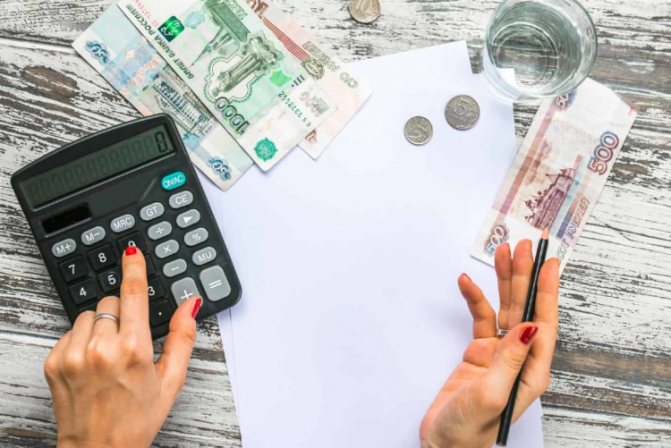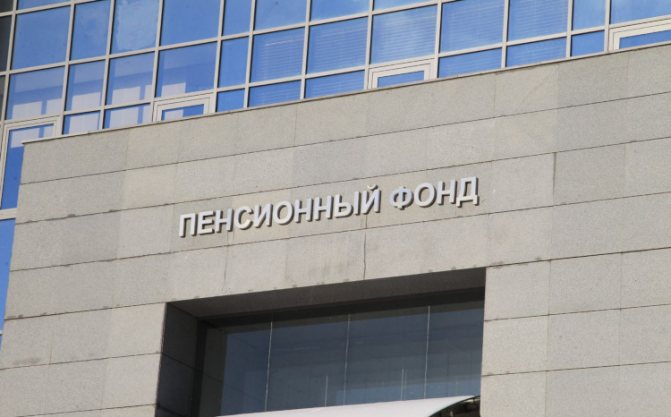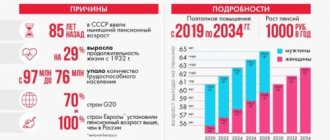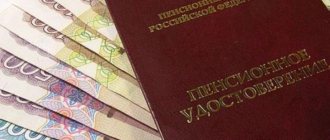What are insurance premiums
In Russia, medicine is conditionally free, and pensions are conditionally state-owned. “Conditionally” because in reality all working citizens pay monthly pension, insurance and social contributions. They do not pay themselves, but through a tax agent, who is the employer. But individual entrepreneurs pay such contributions for themselves, because they do not have a tax agent. They are their own employers. And if they have employees, they pay for them too.
The law obliges individual entrepreneurs to make contributions towards future pensions and contributions for health insurance. Social insurance, the funds of which are used to pay sick leave and benefits for the birth of a child, is a right, not an obligation. That is, payments to the Social Insurance Fund are voluntary.
How to pay contributions to a pension fund and save time? It is best to create a payment order on the tax service website and pay online through the mobile application or the Sberbank website.
Payment of insurance premiums is mandatory for individual entrepreneurs
Who is obliged to pay
Insurance contributions, one way or another, are paid by all citizens. Individual entrepreneurs pay them without exception. Even if an entrepreneur has ceased to operate, but has not been deregistered, payments to the Pension Fund and the Compulsory Medical Insurance Fund remain mandatory. There are judicial precedents in this area: all decisions of judges in such cases are made in favor of the state. All debts are collected from the taxpayer.
Therefore, if an individual entrepreneur decides to stop working, he must notify the Federal Tax Service and liquidate his individual entrepreneur status. Otherwise, insurance premiums will be charged as before.
There are still exceptions, but they are few. Entrepreneurs have the right to refuse to pay for insurance when they are not working because:
- serve in the armed forces;
- are caring for a young child or a child with a disability;
- are caring for a disabled person of the 1st group or an elderly relative over 80 years old.
Of course, any of these statuses must be confirmed by documents.
What are fixed individual contributions
Fixed contributions are payments made by individual entrepreneurs “for themselves.” A fixed payment is established annually and is mandatory for all registered individual entrepreneurs.
In 2020, the mandatory payment consists of two parts - the first, which is paid mandatory (contributions to pension insurance (26%) and health insurance (5.1%) from the current minimum wage for each month of the year), the second - upon receipt of income in amount over 300 thousand rubles.
In 2020, the amount of fixed contributions for individual entrepreneurs is RUB 27,990.
And from income exceeding 300,000 rubles. per year, in addition to the fixed payment, the individual entrepreneur pays an additional contribution of 1%.
The income taken into account in the calculation is determined:
- for OSNO, all income of an individual entrepreneur received by him both in cash and in kind, as well as income in the form of material benefits, taking into account professional deductions, are taken into account. In this case, you can reduce income for expenses, i.e. for the calculation, the same base is taken as for calculating personal income tax;
- for the simplified tax system, income is taken into account in accordance with Art. 346.15 Tax Code of the Russian Federation. The ability to reduce income for expenses is not provided, but the courts think otherwise;
- for UTII, the object of taxation is the taxpayer’s imputed income (Article 346.29 of the Tax Code of the Russian Federation);
- for PSN, the object of taxation is the potential income of an individual entrepreneur for the corresponding type of business activity from which the patent is calculated (Article 346.47 of the Tax Code of the Russian Federation);
- For insurance premium payers applying more than one tax regime, insurance premiums are calculated based on the total amount of taxable income received from all types of activities.
Calculation of insurance premiums
How much money will you have to spend on these deductions? Now these are fixed amounts, which greatly simplifies calculations and payments. You will have to count something only when the profit for the year exceeds 300,000 rubles.
Fixed payments for individual entrepreneurs:
- medical insurance, compulsory medical insurance - 5,840 rubles;
- pension savings, Pension Fund - 26,545 rubles + 1% of income over 300,000 rubles.
Let's figure out how to calculate contributions to the Pension Fund using the sample. The businessman works alone and earned 527,500 rubles. What should he pay? Firstly, a fixed 26,545 rubles for the Pension Fund and 5,840 rubles for medical insurance. Secondly, an additional contribution for income over 300 thousand rubles. Please note that the percentage is calculated not on the entire amount, but on the excess of the limit. That is: (527,500 - 300,000) x 1% = 2,275 rubles.
Total payment amount: 5,840 + 26,545 + 2,275 = 34,660. This is exactly how much a businessman must pay to the state for a year. Fixed contributions of individual entrepreneurs have significantly simplified the life of taxpayers, since previously the amount of payments was tied to the minimum wage.
What is considered income?
Income in the broadest sense of the word is considered to be all money earned from a business minus operating expenses. Depending on the taxation regime, the concept of “income” changes slightly.
The tax regime does not affect the amount of personal insurance premiums in any way, but it does matter in the payment schedule. We will explain below when you need to pay deductions under different tax systems.
Insurance premiums for employees
If an entrepreneur has employees, he automatically acts as their tax agent. Simply put, it calculates and pays income tax for them (13% of salary) and contributes funds to the Compulsory Medical Insurance Fund and the Social Insurance Fund. Unlike individual entrepreneurs, ordinary citizens are required to pay into the Social Insurance Fund.
The amounts here are not exact and are calculated as a percentage of salary. 22% in the Pension Fund, 2.9% in the Social Insurance Fund, 5.1% in the Compulsory Medical Insurance Fund. Let’s assume that an individual entrepreneur officially pays an employee 18,555 rubles. How much money will the state have to pay:
- Personal income tax: 18,555 x 13% = 2,412.15 rubles;
- Pension Fund: 18,555 x 22% = 4,082.1 rubles;
- Compulsory medical insurance: 18,555 x 5.9% = 1,094.7 rubles.
- Social Insurance Fund: 18,555 x 2.1% = 389.655.
The total is 7,978.605. That is, an entrepreneur will pay almost 8 thousand rubles in 1 month (!) to the state for an employee with a “white” salary of 18 thousand rubles. If there are violations in terms of volume and timing, the entrepreneur will be held accountable.

You can calculate insurance payments yourself, or you can use an online calculator
Self-contribution calculator
Mandatory payments of individual entrepreneurs are easy to calculate manually, since most of them are fixed values. They are approved by the government every year. Calculating 1% of income over 300 thousand is also very simple. However, there are modern free tools that will help you perform or check calculations in a few seconds. Find them: type “calculation of insurance premiums” in the search bar. To calculate insurance premiums for individual entrepreneurs, you only need to indicate the date of registration and income.
General rules
The formula for calculating pension contributions “for yourself” is given in Part 1.1 of Article of the Federal Law of July 24, 2009 No. 212-FZ (hereinafter referred to as Law No. 212-FZ). It looks like this:
Insurance contribution to the Pension Fund for the year = minimum wage x tariff x 12 months + 1% of the amount of income exceeding 300,000 rubles
At the same time, the maximum allowable amount of contributions is provided. Thus, regardless of the amount of income, the amount of contributions to the Pension Fund cannot exceed eight times the minimum wage at the beginning of the year, multiplied by 12 and multiplied by the tariff.
Calculate contributions “for yourself”, taxes according to the simplified tax system and UTII, fill out payments in the web service Fill out for free
Please note: this formula will also be valid in 2017, when Law No. 212-FZ loses force, and the rules for calculating and paying contributions will “migrate” to Chapter 34 of the Tax Code (see “Since 2017, insurance premiums will come under the control of tax authorities: what policyholders expect changes").
As practice shows, the “amount of income” indicator causes the most problems. Part 8 of Article of Law No. 212-FZ is dedicated to it (next year and beyond - paragraph 9 of Article 430 of the Tax Code of the Russian Federation). It states how income should be determined under various tax regimes. Let's take a closer look at each of the modes.
Deadlines for payment of insurance premiums for individual entrepreneurs
The main part of the payments (without 1%) must be transferred to the funds before December 31. There are no time limits, and there are no requirements to deposit funds in advance. An entrepreneur can pay a little bit every month, divide the amount into 4 parts and pay quarterly or pay at once. It's his right. Inspection bodies cannot require a different payment procedure.
As for the additional charge, that is, 1%, it is paid until the beginning of July next year. For example, if a businessman earned 700,000 in 2020, then he will deposit the approved amount before January 1, 2019, and 1% of the “excess” 400 thousand before July 1, 2020.
What is the best way to pay: in parts or at once? The answer depends on the specifics of the job. If an entrepreneur is confident that at the end of the year he will freely find 33 thousand rubles without harm to the business, he does not have to bother himself with advances. But practice shows that it is much safer to divide contributions into several small parts and make payments throughout the year.
If you do not pay contributions from individual entrepreneurs to the Pension Fund
In accordance with federal legislation, individual entrepreneurs may be exempt from making a mandatory fixed contribution provided:
- completing military service;
- stay on maternity leave for up to 1.5 years - if payment of contributions to the Federal Compulsory Medical Insurance Fund follows a calendar year;
- care for citizens with disabilities or reaching 80 years of age;
- staying in a place where it is impossible to obtain employment, while living with a spouse who is in military service under a contract - the benefit is provided for a period of up to 5 years;
- living abroad with an existing referral for official employment of a spouse - the maximum period of exemption is 5 years.
Reference! To receive an exemption, you must document your right to the benefit.
Eg:
- for military personnel - a certificate from the military registration and enlistment office, military ID;
- for child care - birth certificate, certificate from social insurance on the accrual of child benefits.
Depending on the grounds for obtaining an exemption, the package of documents differs. The tax office reserves the full right to require additional certificates in order to confirm previously received information. If a refusal is received from the individual entrepreneur, the benefit will be denied without any explanation.
In practice, the tax service is quite satisfied with one document or several. For example, if you are caring for an elderly relative aged 80, you must prepare a copy of his passport and documentary evidence of the degree of relationship. If he is not a relative, it is necessary to prepare confirmation of rights to care - for example, guardianship.
Reducing the amount of taxes due to insurance premiums
Individual entrepreneurs' pension contributions can be used to reduce taxes. This is beneficial because it helps reduce tax by 32 thousand. For small businesses, this could mean zero payments completely. This works slightly differently in different modes.
Individual entrepreneur contributions to the simplified tax system
Taxpayers under simplified taxation pay advance payments every 4 months and income tax at the end of the year. They are allowed to use personal insurance contributions to reduce the amount of payments, and in several ways. When an entrepreneur transfers small amounts to insurance once a quarter, each advance payment can be reduced. If the individual entrepreneur makes the entire amount of payments in December, you can immediately reduce the final payment by 32,385 rubles. This is really for entrepreneurs working entirely on their own.
Unfortunately, if an individual entrepreneur has hired employees, payments can only be reduced by 1/2 of insurance contributions.
How is this implemented in practice? Let’s assume that during the quarter a businessman earned 115 thousand using the simplified tax system. He decided to pay insurance premiums in 3 installments of 10,795. He pays 6% of his income to the Federal Tax Service, that is, for the quarter he will contribute 115,000 x 6% = 6,900 rubles. If he has already paid 10,795 rubles, the advance tax may not be paid at all.
Another option: the entrepreneur did not reduce advance payments and paid for insurance at once at the end of the year. At the end of the period, taking into account advances, he must pay 50 thousand rubles. He can deduct the entire fixed payment from them and pay only 17,615.

You can pay to the Pension Fund and the Compulsory Medical Insurance Fund at once, or in parts, this is the right of an entrepreneur
IP on UTII
Taxpayers on imputation have the right to reduce their tax due to insurance contributions: by 100% if they work alone and by 1/2 with employees. Only personal payments are used in the tax reduction. It is prohibited to reduce the amount in the declaration by employee contributions. The fee is paid quarterly. In order to reduce the payment to the Federal Tax Service by an insurance payment, two conditions will have to be met:
- pay for insurance before paying taxes;
- deposit funds every quarter.
USN and UTII
Taxpayers who combine two tax calculation systems: simplified tax system and UTII, are also allowed to reduce financial obligations using insurance contributions, but according to special rules. For example, an individual entrepreneur does not have hired employees on the simplified tax system, but does have employees on UTII. The simplified payment is reduced by personal insurance, and the imputed amount is reduced by 50% of the transfers for employees.
In the opposite case, when employees are listed according to the simplified tax system, but there is no one according to the imputation, the same rule applies: the simplified tax is reduced by 50% of the employees’ contributions, and the UTII is reduced by the full amount of their own. There should be no problems with calculations, because when combining two regimes, entrepreneurs are required to keep separate records of income and expenses, which means they have all the information about how much they must pay under the simplified regime and how much under the imputed regime.
General taxation system
Individual entrepreneurs extremely rarely operate under the general tax regime. But if for some reason they are forced to use such taxation or are automatically transferred to it due to exceeding the amount of income established by law or the number of employees, it is allowed to reduce personal income tax by the entire volume of personal insurance payments.
"Uproshchenka" and Unified Agricultural Tax
Law No. 212-FZ states that individual entrepreneurs using a simplified taxation system must take into account income according to the rules set out in Article 346.15 of the Tax Code of the Russian Federation. Exactly the same norm will “migrate” to paragraph 9 of Article 430 of the Tax Code of the Russian Federation, which will be in force from January 2020.
In practice, those who use the simplified tax system with the object “income” reflect income and calculate contributions without any difficulties.
The situation is different with entrepreneurs who have chosen the “income minus expenses” object. For them, the question will remain relevant: on what amount to calculate contributions: from income or from the difference between income and expenses.
To dot all the i’s, you need to realize: “income” and “taxable base for a single tax” are two different concepts. The taxable base is indeed the difference between income and expenses, but it is used exclusively to calculate the “simplified” tax. As for contributions, the difference between income and expenses is not taken into account. Instead, you need to take only income, and, based on them, determine the amount of payment to the Pension Fund. Specialists from the Russian Ministry of Finance also adhere to this position (see “The Ministry of Finance recalled how an individual entrepreneur using the simplified tax system must determine the amount of his income in order to pay contributions to compulsory pension insurance”). We would like to add that the described rule will not lose its relevance in 2020.
Fill out and submit a new declaration under the simplified tax system via the Internet for free
A similar situation has developed with individual entrepreneurs who switched to paying a single agricultural tax. Both now and next year they must determine income in accordance with paragraph 1 of Article 346.5 of the Tax Code of the Russian Federation. Contributions are calculated on income, not on the difference between income and expenses. This is also confirmed by officials from the Russian Ministry of Labor (letter dated 02/11/16 No. 17-4/OOG-219; “The Ministry of Labor informed how an entrepreneur on the Unified Agricultural Tax can determine the amount of annual income for the purpose of paying insurance premiums”). Obviously, these clarifications can be used as guidance in 2020 and beyond.
How to submit reports on insurance premiums
If an entrepreneur runs a business alone, without employees, there is no need to report insurance payments. It is enough to bring them in on time. But when you have hired employees, you will have to regularly submit several reports:
- S3V-M to the Pension Fund of Russia department - before the 15th day of the month, after the reporting month;
- 4-FSS - until the 20th day of the month, after the reporting month;
- 6-NDFL and a single calculation form to the tax service within a month after the end of the quarter;
- 2-NDFL to the tax service until April 1 of the year following the reporting year.

The pension fund is paid a fixed amount of 26,545 rubles per year + 1% of income over 300 thousand rubles
Amnesty on contributions to the Pension Fund
Tax amnesty for individual entrepreneurs means a legal way to get rid of accumulated debts for previous reporting periods.
The rule is relevant for individual entrepreneurs who:
- continue their business activities at the current time;
- stopped working as individual entrepreneurs, but still owed mandatory insurance and tax contributions as of a certain date.
The established amnesty affects exclusively the debt of individual entrepreneurs that is registered with them as of:
- January 1, 2020 – for tax collections;
- , 2020 - for other contributions.
It follows from this that existing debt obligations for the listed fees of individual entrepreneurs formed after the established deadlines must be paid in full. The rule is relevant not only to those individual entrepreneurs that have ceased to exist, but also to existing ones.
The amnesty procedure was initiated in 2020. The legislation of the Russian Federation has developed a special mechanism through which debt is written off. The responsibility for canceling debts is assigned to tax service specialists at the place of registration of individual entrepreneurs. The legislation does not require any actions from entrepreneurs.
To date, the amnesty period is not limited in time, which is why the tax authority indicates that the procedure may drag on for an indefinite period. For this reason, if individual entrepreneurs are interested in writing off existing debt obligations in the shortest possible time, there is a need to take an active part in this.
Attention! To write off debt in a short period, it is recommended to independently initiate reconciliation procedures with authorized controllers from the tax service at your place of registration.
In conclusion, we note that each individual entrepreneur pays a fixed contribution to the Pension Fund and an additional 1% on income exceeding 300 thousand rubles. You can calculate using the calculator on the Federal Tax Service website.
In the absence of employees, reporting is not provided to the Pension Fund. By falling under the amnesty, you can get rid of part of your debt obligations.
Responsibility for non-payment of insurance premiums
A businessman will have to be responsible not only for the timely payment of insurance premiums for himself and his employees, but also for reporting:
- There is no report on time - 5% of the debt, but at least 1 thousand rubles.
- Incorrect accounting and understatement of taxable income, non-payment/payment less than necessary - 20% of the debt amount, but not less than 40,000.
- Incorrect reporting to the Pension Fund—500 rubles for each person for whom an error was made.
General taxation system (OSNO)
Until December 2020 inclusive
Now there is a clear instruction for entrepreneurs on OSNO to take into account income in accordance with Article 227 of the Tax Code of the Russian Federation. But even after studying this norm, individual entrepreneurs and accountants are often left with the question: what is meant by income - revenue, or the difference between revenue and professional deductions? The answer can be found in the explanations of officials and judicial practice. Thus, the Ministry of Finance of Russia in letter dated 06.06.16 No. 03-11-11/32724 indicated: an entrepreneur’s income on OSNO is his revenue, not reduced by deductions. This means that contributions to the Pension Fund should be considered as a percentage of all taxable income without taking into account professional deductions (see “The Ministry of Finance announced how an entrepreneur can determine the amount of his income on the OSNO in order to pay contributions to the Pension Fund “for himself””). The same conclusions are contained in the letter of the Ministry of Labor dated December 18, 2015 No. 17-4/OOG-1797. A similar position is taken by the Supreme Court (see “Supreme Court: Individual entrepreneurs on OSNO calculate insurance premiums “for themselves” based on all income subject to personal income tax without taking into account expenses”).
Example 1
During 2020, IP Ershov received revenue in the amount of 500,000 rubles.
Ershov’s professional deductions for this year amounted to 300,000 rubles.
The fixed part of pension contributions “for oneself” is equal to RUB 19,356.48. (RUB 6,204 × 26% × 12 months).
The portion of contributions calculated from the amount of income is equal to 2,000 rubles ((500,000 rubles – 300,000 rubles) x 1%).
The total amount of pension contributions for 2020 is 21,356.48 rubles (19,356.48 + 2,000).
In 2020 and beyond
Starting in 2020, the situation will change. This is due to the fact that when calculating contributions “for themselves”, entrepreneurs on the general system will be guided by subparagraph 1 of paragraph 9 of Article 430 of the Tax Code of the Russian Federation. According to this norm, income will be determined in accordance with Article 210 of the Tax Code of the Russian Federation, which is devoted to the tax base, that is, the difference between income and deductions. This means that individual entrepreneurs will begin to calculate pension contributions not from the amount of income, but from the difference between income and professional deductions. This was confirmed by the Ministry of Finance of Russia in a letter dated October 25, 2016 No. BS-19-11 / [email protected] (see “Starting from 2020, the income of individual entrepreneurs on OSNO for the purpose of paying contributions to the Pension Fund “for themselves” will be determined taking into account expenses”) .











